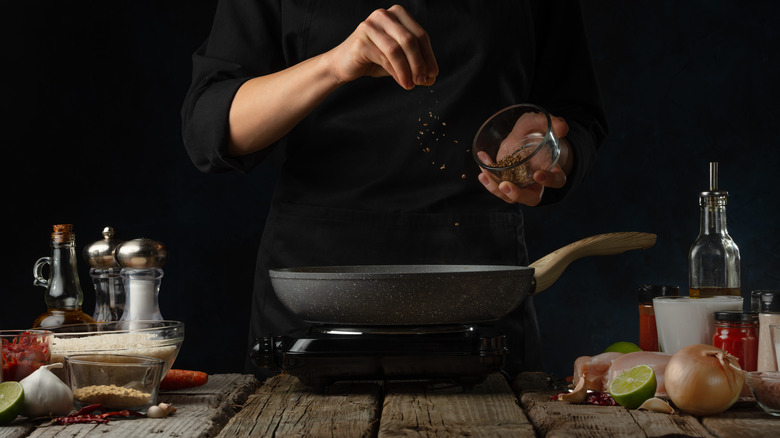What It Really Means To Bloom Spices
Aromatic and deeply flavorful, spices are endlessly important in the realms of cooking and culinary arts. Down through the centuries spices developed into a key trade industry that once dictated the powers of nations and cultures, per World History Encyclopedia. In addition to the colors, smells, and flavors they impart to food, they're also redolent of familial cooking and traditional recipes that have been passed on from generation to generation. And, they have many nutritional benefits, according to the National Library of Medicine.
Whether used in a whole or ground iteration, spices can lend deep, rich flavor, or sometimes a subtle nuance, to dishes. The significance of spices is clear, but what might still be a bit amorphous for some is the technique of "blooming." Read on to learn all about blooming spices, what it does, and why you should consider doing it even in certain recipes that don't call for it.
What does it mean to bloom spices?
There's actually nothing more to blooming than merely heating or toasting spices (or herbs), either in oil or in a dry pan, according to Kansas Living Magazine. That's it! No special technique here — just the mere application of heat to a spice (along with an oil or fat), which helps to bring out the spice's innate flavor and further infuse the dish. BuzzFeed notes that toasting is the dry-heat method of heating spices in a dry pan while blooming involves a modicum of oil and is more of a moist-heat cooking method. Toasting is usually reserved for whole spices; most ground, raw spices will burn if added only to a dry pan.
According to Nu Sci Magazine, compounds within herbs or spices are "sometimes prevented from evaporating when they are contained within whole seeds or locked in through drying process," but when heat is applied, the compounds "dislodge from the spices and more flavor molecules" are released. While heat is certainly an important component, Nu Sci also states that a fat component is necessary for proper blooming: Spices bloomed in a dry pan or water won't become nearly as potent as spices bloomed in oil. Cook's Illustrated notes, "The main flavor compounds in many spices and some herbs are largely fat-soluble. So by briefly heating spices (or herbs) in fat before the liquid goes into the pot, you can extract far more flavor than you could by simply simmering these ingredients in water."
Blooming spices brings out more flavor
There is a difference between adding the dry, cold spice to a hot pan during the cooking process and blooming it before incorporating it into the final dish. It's also important to note that while cooking with unbloomed spices is certainly okay, the mere application of heat causes a brightening of flavor, and there's a difference when you add the ground spice to the dish straight from the shaker bottle (via Kansas Living Magazine). Also, don't limit yourself to only blooming spices — herbs also bloom incredibly well. Another note is that some cooks toast or bloom whole spices before grinding them.
Indian food is one of the world's cuisines that relies on spice blooming, which is clear in the uber-flavorful dishes within the Indian culinary catalog. Many Indian dishes call for a spattering of bloomed spices and infused oil over the top of the finished dish, which adds an intense, amazingly flavorful note to the final, composed dish, often referred to as chhonk, according to The New Yorker.
What spices should you bloom?
When you're blooming spices, there are some important things to keep in mind. According to Simply Recipes, use oil with a high smoke point, be mindful of how long certain spices need to bloom (don't add a whole bunch of spices at once and risk burning some while others still need to cook), and watch out for the spattering or splashing of oil. In addition to spices and herbs, some cooks also add aromatics or vegetables (such as alliums) to the oil, along with the spices and herbs. This is a common base for myriad dishes. It's also generally recommended to use a smaller pan when blooming.
Some of the top spices for blooming: mustard seeds, cumin seeds, fenugreek seeds, fennel seeds, cinnamon, cloves, and dried chilies. Truly, though, there is no limit to the spices and herbs you can bloom. Feel comfortable experimenting with blooming various spices and experiencing the changes in flavor.
No matter which spices you're using, consider blooming them. It's nothing more than improving on the inherent flavor already locked within the spice, so why not harness that?



